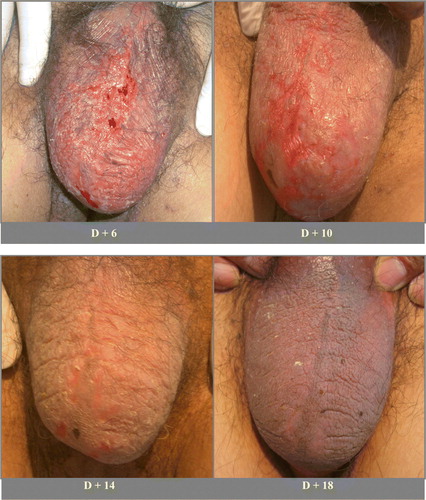To the Editor
In November 2007, a 65-year-old man with sigmoid colon cancer and para-aortic lymph node metastases underwent anterior resection. One month later, he received a first course of adjuvant chemotherapy consisting of intravenous oxaliplatin 130 mg/m2 over 2 hours on Day 1, and 5-fluorouracil (FU) 750 mg/m2 over 24 hours and leucovorin 20 mg/m2 from Day 1 to Day 5. This was to be repeated every 3 weeks. The cumulative dose of 5-FU after the first cycle was 3 750 mg/m2. On the sixth day of the first cycle, he started to complain of severe continuous pain in the scrotum, accompanied by erythema, swelling, and desquamation. He also had a mild fever, an oral ulcer, and intermittent diarrhea. He could not walk or sit down due to the severe scrotal pain. His medical history included untreated diabetes mellitus and hypertension. He denied a previous allergic reaction to any medicine. On physical examination, the entire scrotum was diffusely erythematous, with erosive cutaneous patches with no direct tenderness of either the testis or epididymis (). His palms and soles had pain with erythema consistent with grade 2 hand-foot syndrome (HFS). There were also ulcerative patches on the lower lip. Laboratory test results, including a complete blood count, were normal. A diagnosis of 5-FU-induced HFS involving the scrotum and penis was made. The patient was treated with a soothing balm, analgesics, and antibiotics to prevent secondary infection. The skin lesions and erythema, swelling, and ulceration that involved the scrotum and penis resolved within 2 weeks ().
Figure 1. Photographs of the diffuse erythematous and erosive cutaneous patches on the scrotum and penis. These resolved within 2 weeks.

A second cycle of chemotherapy, with 75% of the initial dose of 5-FU, was started on the 25th day after starting the first cycle. On the third day of the second cycle, he presented with grade 2 oral mucositis and grade 2 HFS with scrotal involvement. Although the mild HFS and oral mucositis recurred until he finished the 6th cycle of chemotherapy, his symptoms were manageable without further reduction of the 5-FU dose. At present, he shows no evidence of disease.
Hand-foot syndrome, which is also known as palmar-plantar erythema, palmar-plantar erythrodysesthesia, acral erythema, and Burgdorf's reaction, is a chemotherapy-induced skin reaction. It is known to be caused by a variety of chemotherapeutic agents and dosing schedules Citation[1]. The incidence of HFS is difficult to determine, although in some series, HFS occurred in 6 to 42% of patients Citation[2], Citation[3]. In the pathogenesis of HFS, both the peak level and total cumulative dose of chemotherapeutic drugs are important because regimens with either a bolus or continuous infusion can cause the reaction in a dose-dependent manner Citation[3]. The mainstay of the management of HFS is interrupting the causative therapy and, if necessary, reducing the dose. Discontinuation of the offending agent generally leads to skin regeneration over 1 – 2 weeks Citation[4].
The scrotum and penis are very unusual sites of acral erythema. The mechanism of acral erythema on the scrotum is not well understood. It can be thought to be a direct cytotoxic effect of the chemotherapeutic agent on epithelial cells Citation[5]. Similar to the hands and feet, the scrotum and penis are susceptible to local trauma from shearing stress during daily activities such as walking or sitting. Thus, it is possible that micro-dermal capillary damage resulting from local trauma affects the scrotum and then 5-FU released from the capillaries causes an inflammatory reaction Citation[6]. Another theory considers the higher concentrations of chemotherapeutic drugs in eccrine sweat glands or ducts, which are abundant on the scrotum and penis, much like on the palms and soles Citation[7–9]. This theory holds that 5-FU metabolites are eliminated via the eccrine system and that the resulting excretion in these areas may be the cause of HFS.
HFS on the scrotum and penis can be found more severe than on the palms and soles because the former location makes early detection difficult. This adverse effect can cause significant discomfort, impair functions, and induce severe secondary infection leading to hospitalization or worsening of the quality of life. However, there is almost nothing in supportive care measures that has been proven to be effective in controlling the symptoms, except interrupting therapy. Therefore, early detection and interruption are important for resolving the condition before it progresses. High-dose fluorouracil is widely used in a variety of continuous infusion regimens for various tumors. When using 5-FU or its derivatives, clinicians should be aware of this disease entity as a serious adverse effect, which is similar to classic HFS.
This work was presented at the Heart Rhythm Society, Denver, Colorado, 11/5 2007. Declaration of interest: None declared.
References
- Scheithauer W, Blum J. Coming to grips with hand-foot syndrome. Insights from clinical trials evaluating capecitabine. Oncology 2004; 8: 1161–8
- Lokich JJ, Moore C. Chemotherapy-associated palmar-plantar erythrodysesthesia syndrome. Ann Intern Med 1984; 101: 798–9
- Vogelzang NJ, Ratain MJ. Cancer chemotherapy and skin changes. Ann Intern Med 1985; 103: 303–4
- Scheithauer W, McKendrick J, Begbie S, Borner M, Burns WI, Burris HA, et al. Oral capecitabine as an alternative to I.V. 5-fluorouracil-based adjuvant therapy for colon cancer: Safety results of a randomized, phase III trial. Ann Oncol 2003; 14: 1735–43
- Nagore E, Insa A, Sanmartín O. Antineoplastic therapy-induced palmar plantar erythrodysesthesia (‘hand-foot’) syndrome. Incidence, recognition and management. Am J Clin Dermatol 2000; 1: 225–34
- Wilkes GM, Doyle D. Palmar-plantar erythrodysesthesia. Clin J Oncol Nurs 2005; 9: 103–6
- Baack BR, Burgdorf WH. Chemotherapy-induced acral erythema. J Am Acad Dermatol 1991; 24: 457–61
- Susser WS, Whitaker-Worth DL, Grant-Kels JM. Mucocutaneous reactions to chemotherapy. J Am Acad Dermatol 1999; 40: 367–98
- Saif MW, Elfiky A, Diasio R. Hand-foot syndrome variant in a dihydropyrimidine dehydrogenase-deficient patient treated with capecitabine. Clin Colorect Cancer 2006; 6: 219–23
